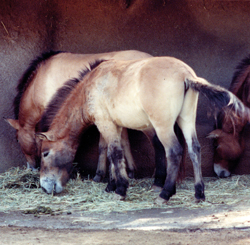FOCUS: news of interest about creation and evolution
Humans in zoo—by choice
As visitors to London Zoo paused outside the exhibit labeled ‘Humans’, several children could be heard asking ‘Why are there people in there?’ A zoo official explained that displaying eight scantily clad men and women in the bear enclosure ‘teaches members of the public that the human is just another primate’.
One of the captive Homo sapiens echoed this, saying ‘A lot of people think humans are above other animals. When they see humans as animals, here, it kind of reminds us that we’re not that special.’
But that message rings hollow, for, unlike their caged neighbours, the people commute home each evening at closing time—for they were in the zoo by choice. Which fits exactly what the Bible says—men and women are indeed special; created in the image of God and given dominion ‘over all the earth’ (Genesis 1:26–28).
- MSNBC News, www.msnbc.msn.com/id/9087023/, 12 September 2005.

Rapid mountain-building
Mountains are made much more quickly than previously thought, according to new research published in the science journal Nature.
An international team of scientists, using a unique ‘cold crust’ computer model and new dating techniques, says it only takes some 13 million years to grow a mountain instead of 40 million years as formerly believed.
The researchers also found that the rocks remained much cooler than conventionally believed. These and other findings have surprised many. One commentator observed: ‘Conventional wisdom says that changes to crustal rocks pushed down deep when continents collide develop over millions of years. But it seems that some metamorphism [changes in rock] may be caused by tectonic events lasting only a decade.’
The science books will have to be rewritten yet again, but they still don’t have it right. That is because their answers depend on their assumptions, and they have ignored the effects of the global Flood. The Bible reports that the mountains rose (as the ocean basins sank) toward the end of the Flood (Psalm 104:8)—all within a few months.
- Nature, 30 June 2005, pp. 1171, 1191–1196.

Saturn’s rings becoming dimmer
Yet another observation from the Cassini space mission to Saturn is challenging evolutionary cosmologists (see Creation 27(3):7, 2005).

This time it’s Saturn’s trademark shimmering rings —astronomers are puzzled as to why the rings ‘have dramatically changed over just the past 25 years’. In particular, parts of the D ring—Saturn’s innermost ring —have grown dimmer since the Voyager spacecraft sent back photos in 1981. (Similarly, in Creation 27(4):9, 2005 we reported the recent discovery that Neptune’s outer rings have ‘dramatically deteriorated’.) What’s more, a piece of the D ring has even shifted 200 km (125 miles) closer to Saturn.
One can see why such rapid changes would be a puzzle for those who believe in a universe billions of years old—but are not surprising from a biblical (i.e. young universe) perspective.
- CNN.com, www.cnn.com/2005/TECH/space/09/06/saturn.rings.ap/index.html, 7 September 2005.

Car-maker copies boxfish design
We have earlier reported (Creation 25(3):56, 2003; creation.com/boxfish) how the boxfishs’ ‘boxy’ design renders them stable and manoeuvrable as they swim in turbulent waters and swirling currents—testimony to their Creator (Genesis 1:20–22). Now Mercedes-Benz has announced that they are using the boxfish as a model for a fuel-thrifty concept car.

The company’s engineers say that despite the boxfish’s cube-shaped body, it is ‘outstandingly streamlined and therefore represents an aerodynamic ideal’. In wind tunnel tests of moulded clay cars modelled on the boxfish, researchers measured a drag-coefficient (wind-resistance factor) of 0.095—a ‘previously unprecedented’ figure in automotive engineering.
The car’s developers also say that the boxfish is a prime example of rigidity and light weight. Its skin consists of hexagonal, bony plates which provide maximum strength with minimal weight—a great way to protect the animal from injury. Noting this, engineers have designed the car’s bodyshell along the same bionic principle; cutting total weight by one-third without diminishing strength and car safety.
- New Zealand Herald, www.nzherald.co.nz/section/9/story.cfm.?c_id=9&objectid=10331424, 13 September 2005.
German Car Fans, www.germancarfans.com/news.cfm/newsid/2050607.004, 15 September 2005.
Smart bees
When a bee returns from a foraging mission, other bees gather around to watch it run around in a tight figure-of-eight, waggling its abdomen as it does so.
Controversy has raged about the purpose of the ‘waggle dance’ since the 1960s, when it was suggested that returning bees deliver a complex set of instructions about how to find a rich nectar source (Creation 17(4):46–48, 1995; creation.com/beedance). Nobel Prize winning zoologist Karl von Frisch speculated that the direction the bees point while performing the dance indicates the direction of the food source in relation to the sun; while the intensity of the waggles indicate the distance. But many were sceptical, partly because it was widely believed that bees could not decode such a complex message.
Now, however, researchers have fixed radar transponders to bees which had watched the waggle dance, and tracked their route to the food source. They also took bees to release sites away from the hive, and saw that the bees flew to where the feeding site should have been had they not been displaced, showing they were following the dance instructions accurately (rather than odours or regular routes).
So, bees are smart—consistent with having been designed by a divine Designer (Romans 1:20).
- Nature, 12 May 2005, pp. 205–207.

Creation in Ukrainian schools
Church leaders in Ukraine will help to develop a public school curriculum which ‘will include lessons about morality and creationism’. The theory of evolution will continue to be taught.
Creation evangelist Sergei Golovin (pictured, interviewed in Creation 22(4):23–26, 2000), who lives in Ukraine, has been watching these events unfold with keen interest. He writes: ‘While the idea of a “Christian Ethics” optional school course has been promoted by Christians in Ukraine for several years, this is the very first time it is (1) proclaimed on so high a level, (2) connected with teaching creation. This second point is crucial—if we want to teach our children moral absolutes of honesty, purity, unselfishness and love, we have to show their absolute source—God the Creator, not evolution of man’s fallible ideas.
The main problem is that anyone raised in the former Soviet school system—including the teachers of today’s teachers—have never heard anything but evolution. That is why it is so important for us to spread the Creation message to educators as well as the school children, who with their “why?” questions could actually be the best missionaries to their teachers.’
[Donations earmarked for Sergei’s ministry sent to any CMI office will be forwarded in full.]
- Chicago Tribune, 24 June 2005, p. 12.
Mithen’s music musings
According to the Bible, man has had speech and musical capacity from Adam’s day (Genesis 2:23, 4:21).
But Steven Mithen, atheistic professor of ‘early prehistory’ at the University of Reading, UK, instead assumes (and proclaims in his writing) human evolution and evolutionary origins of human intelligence.
And now he’s pondering why humans are musical. Writing in New Scientist, Mithen dismisses renowned fellow atheistic evolutionist Steven Pinker’s view that music is an evolutionary accident, a by-product of evolving language. Instead, Mithen contends that our capacity for music evolved along with our capacity for language. Further, he suggests that when we make music, ‘Perhaps what we are really doing is exploring the evolutionary history of humankind: making sounds that are uncertain memories of a shared ancestral past, a time when we communicated not with words but with melody, pitch and rhythm.’
Mithen says he’s also discovered that particular pieces of music helped him envisage the lives of our [supposed] immediate human ancestors and their relatives in a way that their artefacts and fossil remains had failed to. ‘I had long thought that australopithicenes had slept on the ground. But listening to Bach’s Prelude in C Major, I could more easily picture them waking in tree-top nests in the east African dawn 3 million years ago. Similarly, I realised that Homo ergaster 1.8 million years ago was the first species with an anatomy fit not only for walking and running, but also moving and dancing in a rhythmic fashion.’
- New Scientist, 16 July 2005, pp. 46–47.

Horse tales
The oft-heard contention that ‘horses are a textbook example of evolution’ continues to be promoted, despite the weight of arguments against it. (See ‘The non-evolution of the horse’ Creation 21(3):28–31, 1999, also at creation.com/horse.) Science journal used those exact words when reporting a DNA analysis published in PLOS:Biology which ‘has straightened out some of the tangled history of the North American horse and reduced its species from 50 to 2’.
From fifty to two! How so? The evolutionary researchers concede that ‘while the overall picture of equid [horse] evolution is well known, the details are surprisingly poorly understood’. So there is excitement at the prospect that DNA studies such as this latest one ‘will help clear up the complicated and confusing history of horses’ (our emphasis).
But researchers ought to wonder at the fact that this latest study was able to analyse mitochondrial DNA from horse fossils they claim are up to 50,000 years old—how could it have remained intact for that long? The answer is that it didn’t—the horse fossils would be no older than a few thousand years at most.
Furthermore, reducing the number of species from fifty to two sounds like the elimination of a lot of evolution, by any reckoning, not its confirmation.
- Public Library of Science: Biology, August 2005, accessible via biology.plosjournals.org/perlserv/?request=get-document&doi=10.1371/journal.pbio.0030241.
Science, 15 July 2005, p. 378.

Footprints not so long-lasting
When South African palaeontologist Theagarten Lingham-Soliar found a metre-wide (over 3 ft) footprint of a giant brachiosaur preserved in a rock in Zimbabwe, he thought it’d be safe enough while he went to fetch what he needed to cast a mould of the track.
Sadly, he was just too late—while he was away, a herd of elephants obliterated it.
This shows that they couldn’t have been exposed for millions of years, but must have been preserved rapidly.
- New Scientist, 26 June 2004, p. 56.

Pool of Siloam found
Archaeologists have uncovered in the Old City of Jerusalem the place where Jesus cured a man blind from birth (John 9:7). The pool of Siloam was fed by the renowned Hezekiah’s Tunnel (2 Kings 20:20; 2 Chronicles 32:30) and is ‘a much grander affair’ than archaeologists had thought, with three tiers of stone stairs allowing access to the water.

In the soil in one corner of the pool, archaeologists found coins dating from around AD 66 to 70, indicating the pool had begun to be filled in by that time. Because the pool sits at one of the lowest spots in Jerusalem, winter rains flowing down the valley deposited mud into it. If it was no longer being cleaned out, the pool would have quickly silted up and become hidden under sediment.
‘Scholars have said that there wasn’t a pool of Siloam and that John was using a religious conceit’ (to illustrate a point) said James H. Charlesworth of Princeton Theological Seminary. ‘Now we have found the pool of Siloam … exactly where John said it was.’ A Gospel that was thought to be ‘pure theology is now shown to be grounded in history’, he said.
Genesis, too, is grounded in history—it is not a metaphor, or poetry, nor ‘religious conceit’, but actual history. From Genesis we understand the origin of sin and death which are so logically foundational to the Gospel message—why it was necessary for Jesus, the author of life, to be sent to die on our behalf. Sadly, many are kept from trusting the Bible’s clear message of salvation because they think they cannot trust the Bible’s clear message about history.
- Los Angeles Times, www.latimes.com/news/science/la-sci-siloam9aug09,0,5974214.story, 16 August 2005.

The leopard’s friend
A cow in a village in Gujarat, India, gets visited regularly … by a leopard!
Wildlife warden Rohit Vyas said: ‘It was unbelievable …, they approached each other at very close proximity and the fearless cow would lick the leopard on its head and neck.’ Another witness described a similar encounter: ‘… the cat ducked under the cow’s neck, stretched out lazily and began to purr. At first the cow ignored its companion but eventually gave into the feline’s playful nudges and started licking its fur as if it was one of its calves.’
Some suggest that when the wild leopard was born it saw the cow and became ‘imprinted’ on it.
We have previously reported (Creation 24(4):14–15, 2002) of a lioness that adopted a baby oryx (type of antelope) and even guarded it against predators. These intriguing reports hark back to God’s ‘very good’ creation (Genesis 1:31) before death had intruded and when all creatures were herbivores (Genesis 1:30). The prophet Isaiah foresaw the restoration of our present, sin-cursed world, including that ‘The leopard shall lie down with the young goat, the calf and the young lion and the fatling together …’ (Isaiah 11:6).
New species—but evolution it ain’t
New Scientist reports that a new species of insect may have arisen ‘in an evolutionary blink of an eye’ as a result of hybridization between two species of fruit-maggot flies.
Genetically, the honeysuckle maggot looks like a hybrid of two native (North American) fruit-maggot species, the blueberry maggot and the snowberry maggot.
The discovery prompted evolutionary biologist Thomas Dowling (Arizona State University) to quip: ‘It makes one think hybridization could be important in generating biodiversity.’
But he is wrong. The new species arose simply by mixing existing information together. The genes present in the honeysuckle fruit-maggot flies were simply inherited from the blueberry and snowberry fruit-maggot flies, i.e. they already existed in the two parent species—which were in the same created kind. No evolution of new genes has taken place.
Evolutionists are often surprised when new species appear because their standard millions-of-years view is that organisms would require long periods of time to adapt. But as we’ve often said (see, e.g. ‘Speedy species surprise’, Creation 23(2):13–15, 2001; creation.com/speedy), populations of organisms have a wonderful ‘built-in’ genetic capacity for rapid adaptation in the face of environmental opportunity/change.
- New Scientist, 30 July 2005, p. 12.
Nature, 28 July 2005, pp. 546–549.
Killer theory
Murder is part of human nature, argues evolutionary psychologist David Buss, of the University of Texas. He claims that humans are programmed to kill, and that this can be traced back to the ‘ruthless evolutionary drive to reproduce’. Killing an enemy would boost a man’s social status and improve his chances of attracting a mate, he says.
Professor Buss argues that murderers’ genes won the evolutionary battle over those of their victims, with the result that the instinct to kill now lies dormant in all of us.
Sadly many who are ignorant of the real reasons for mankind’s capacity for evil today might well be influenced by Professor Buss’s outlandish claims—with tragic consequences. (All the more reason to proclaim the truth of the real history of the world, from the Bible.)
- The Courier Mail (Australia), 13 May 2005, p. 3.

“Dino tree” goes on sale
The Wollemi pine, previously thought to have been extinct for millions of years until discovered in 1994 growing near Sydney, Australia, is now being offered for sale.
Potted three-metre tall trees grown from cuttings of the originals are priced at up to AU$50,000 (~US$38,500). Smaller propagated seedlings are expected to fetch about AU$2,000 (~US$1,500).
It looks like quite a lucrative industry is developing around the idea that this tree dates back to the ‘Age of Dinosaurs’, over 65 million years ago. How sad that the frenzy over the Wollemi pine is all based on a false premise, as we’ve pointed out many times (e.g. Creation 27(4):8, 2005)—the ‘millions of years’ have never existed.
- ABC News Online, www.abc.net.au/news/newsitems/200508/s1440353.htm, 18 August 2005.
Update—see “Dino tree” project ends
Radioactive dating warning
Geologists from the UK and the USA recently warned of new ‘pitfalls’ with radioactive dating. The team was led by Jon Davidson of the University of Durham, and used equipment with improved measurement precision. They found that the basic assumptions behind one widely used and highly regarded method (mineral isochron) are ‘invalid in many instances’. Further, they found the standard tests geologists use to check the quality of the radioactive dating results could not be relied upon.
For further examples of dating pitfalls, see Creation 27(3):44–49, 2005.
- Geology, January 2005, pp. 29–32.

Modern Neandertals
Archaeologists report they have uncovered further fossil evidence of interbreeding between Neandertals and modern humans. Fossil remains from the Mladeč Caves in the Czech Republic have been ‘dated’ at 31,000 years old, with bones/skulls showing both ‘modern’ and Neandertal features.
This is yet more evidence that Neandertals were fully human, not ‘soul-less pre-Adamites’ as some contend.
- Nature, 19 May 2005, pp. 332–335.
Washington Post, 19 May 2005, p. A03.


Readers’ comments
Comments are automatically closed 14 days after publication.